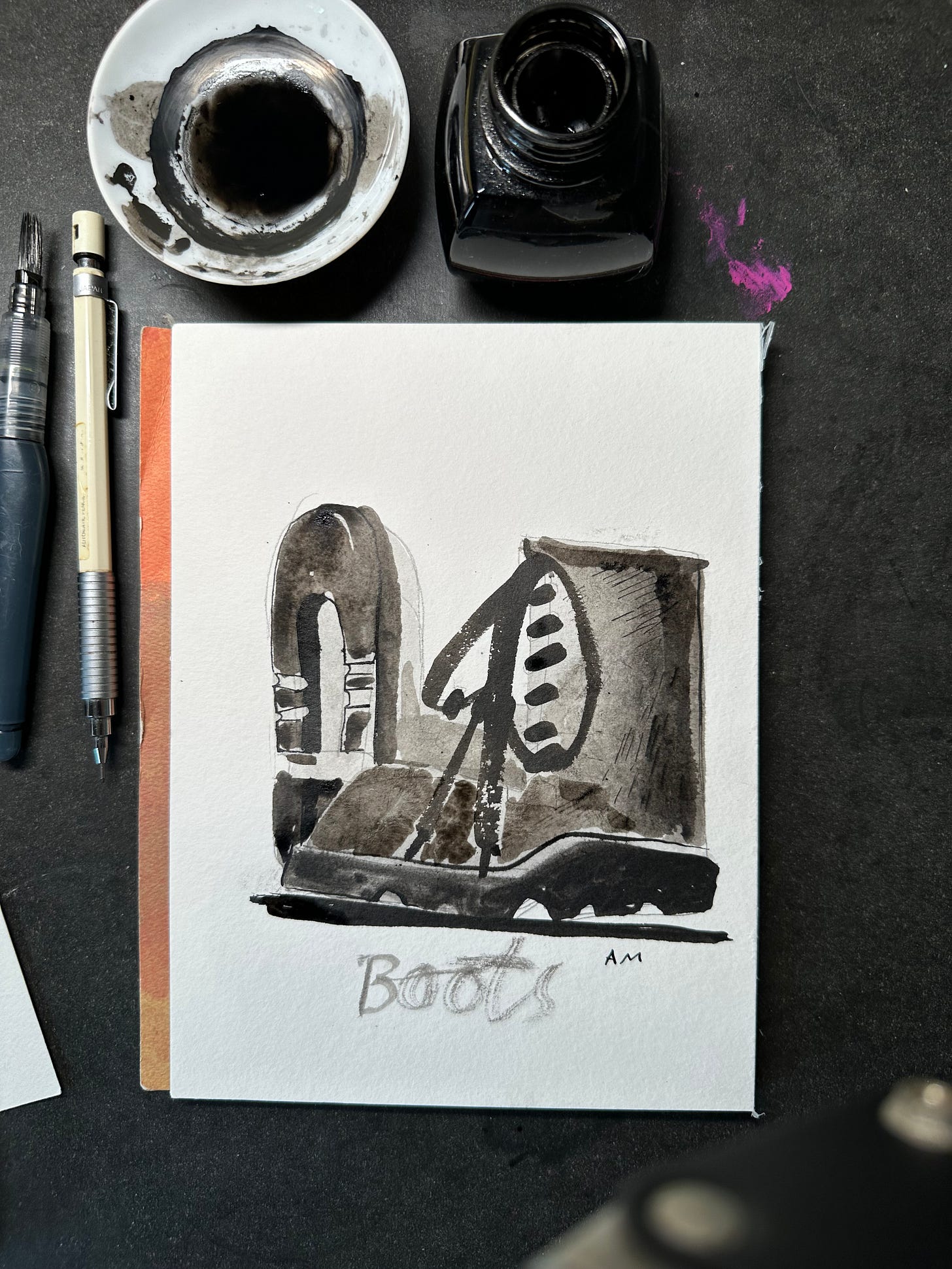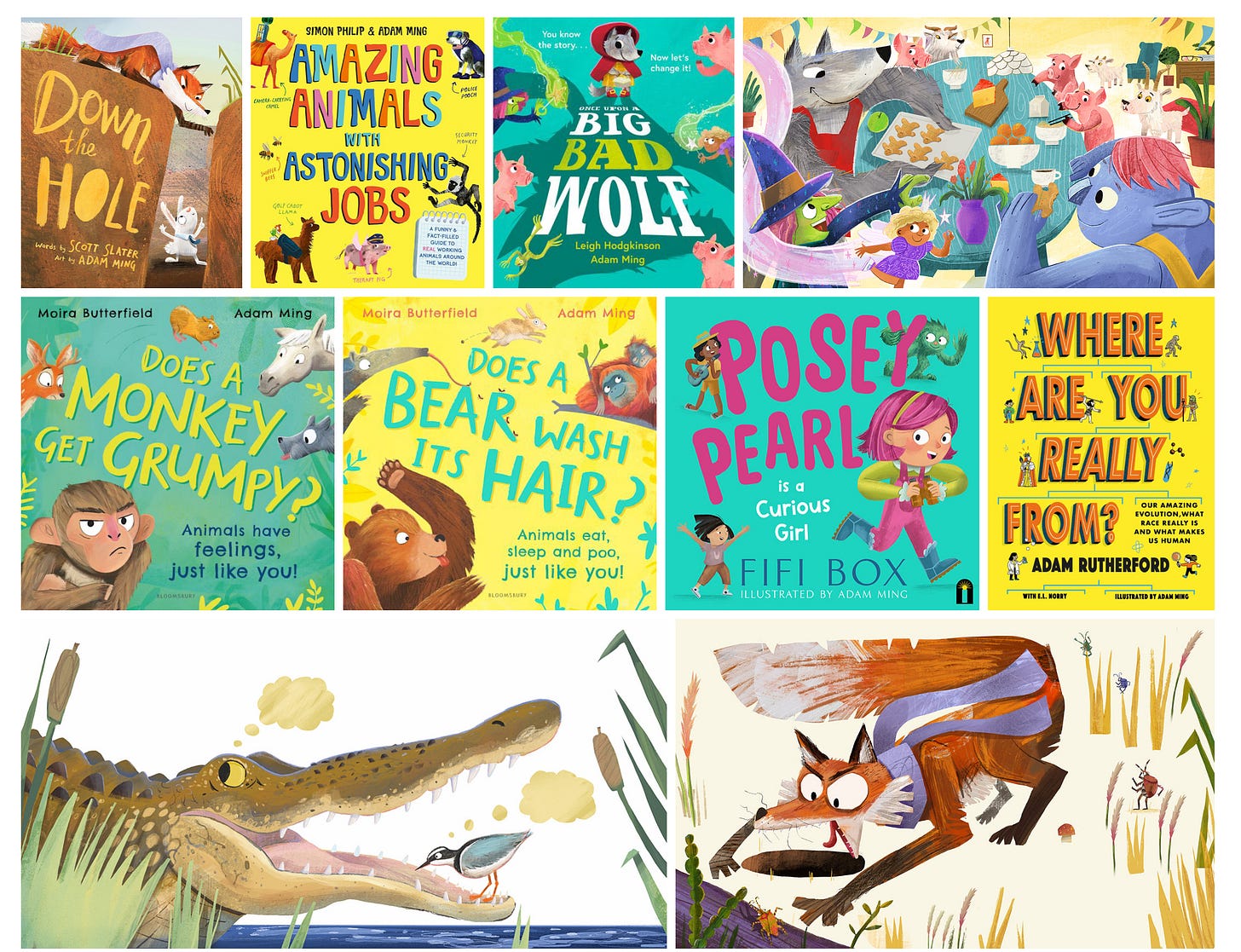03: Building Consistency
"We are what we repeatedly do. Excellence, then, is not an act, but a habit." - Aristotle
You’re Reading Adam Ming’s Daily Blog, This month I’m writing a series about taking time for your creative practice. Each post, includes an invitation to spend Ten minutes developing your creative practice.
I’m doing this in October to complement any Drawing challenge you might be doing. I will be doing the classic inktober.
If you want to get this in your inbox, you must first be a subscriber of Ten Minute Artist, then toggle the Daily Blog on.
Or you can just bookmark this page and check in whenever.
Today's 10-Minute Invitation
Spend your 10 minutes today setting up your "creative arena." This could be a corner of your room, a specific chair, or even a particular playlist. Arrange your tools and create any visual cues that will signal it's time to create. If possible, try to link this space to an existing daily habit.
How I became consistent, developed a ‘style’, and won a ‘Book of the Year’ award.
It was 2.11am when my agent text me, right after she cheered so loud that her hands hurt. A book I Illustrated won ‘book of the year’ in its category.
I guess that makes me an award winning illustrator? This would never have happened if I didn’t become consistent.
I have never been consistent.
For the first 40 years of my life, never. Maybe this is because I saw myself as a bit of an explorer. This would be evident in my art style or lack thereof. When I was asked by an academy award winning art director to produce a portfolio for a job interview, my response was, tell me what you need, give me an hour, and I’ll get it done for you.
In the early 2000’s that was quite a feat, I got the job.
I didn’t have a portfolio because I didn’t want to be consistent. I wanted to try new things always.
Until one day just before the pandemic hit,I got a thought. And it said, “you need a style”.
And without any resistance or need for explanation I understood what those words meant. It was like, it’s time to stop playing around and start committing to something.
Time to be consistent.
But consistently what?
I gave myself two constraints.
Draw in clean black lines, use stark black shadows and a yellow spot colour. I made about 250 drawings in this style and put it on instagram.
And nothing happened for 2 years…
Then one day I got an email asking me if I wanted to illustrate a book in that style.
I said yes, and this is the book that won the award.
Consistency is born out of constraints.
I’ve never been consistent before, but since then I’ve illustrated 10 books in 3 years. I was just thinking yesterday that I live a ‘boring’ and simple life. It’s a boring and simple life of my own design.
You can’t design a whole life in an afternoon, but you can design how you will spend 10 minutes. And if you get good at that it can grow to fill your whole life.
Day 3: Building Consistency
We've explored taking time and overcoming resistance. Today, we're going to try to figure out consistency. Let's talk about how we can turn our creative moments into a sustainable habit.
Why Building Consistency Matters
As a picturebook illustrator, I've learned that consistency is the secret sauce of creativity. It's not about creating masterpieces every day or waiting for the muse to strike. It's about showing up, day after day, and putting in the work.
Consistency matters for several crucial reasons:
Skill Development
Every time you practice, you're laying down neural pathways in your brain. It's like creating a path through a field - the more you walk it, the clearer and easier to follow it becomes. Consistent practice strengthens these pathways, making your skills more automatic and refined over time.
Overcoming the Myth of Inspiration:
We often think great art comes from moments of inspiration, but that's rarely the case. By showing up consistently, you're training your mind to be creative on demand. You're proving to yourself that creativity isn't about waiting for inspiration, but about creating the conditions for it to flourish.
Building Creative Identity:
When you practice consistently, you start to see yourself as a creator. It becomes part of who you are, not just something you do. This shift in identity is powerful - it makes the act of creating feel natural and necessary, rather than a chore.
Compound Effect:
Small actions, repeated consistently, lead to big results. Ten minutes a day might not seem like much, but over a year, that's over 60 hours of focused creative work. The progress you'll see over time can be astounding.
Overcoming Perfectionism:
Consistent practice helps you focus on the process rather than the outcome. When you're showing up every day, you learn to let go of the need for every piece to be perfect. This freedom often leads to more authentic and innovative work.
Life Integration:
When your creative practice becomes consistent, it starts to integrate with the rest of your life. Just as I've made my studio visits a non-negotiable part of my routine, your daily 10-minute practice can become as natural as brushing your teeth.
Resilience Building:
Consistency builds creative resilience. On days when you don't feel motivated or inspired, you show up anyway. This builds a mental toughness that serves you not just in your art, but in all areas of life.
Remember, the goal of the Ten-Minute Artist is to build a sustainable, long-term relationship with your creativity. By focusing on consistency, you're not just improving your art - you're transforming yourself into someone who creates as naturally as they breathe.
Understanding Habit Formation
To build consistency, it's crucial to understand how habits form. The habit loop consists of a cue, a routine, and a reward. By intentionally designing this loop for our creative practice, we can make consistency feel more natural and automatic.
Your Creative Toolkit
1. Environmental Cues:
In my own practice, instead of a specific time, my cue is when I enter the studio. I see the studio as an arena. By associating a specific space with your creative work, you create a strong environmental cue to trigger your practice.
2. Preparation and Invitation:
I always make sure the space and tools are all set up the day before so it's very inviting. This reduces friction and makes it easier to start your practice.
3. Energy Management:
I normally enter the studio after a good night's sleep or some quality time with family, both of these serve as energy rituals. Ensuring you're energized before your practice can significantly boost consistency.
Strategies for Building Consistency
Create a Ritual: Develop a small ritual that signals the start of your creative time. This could be as simple as entering your designated creative space, like my studio.
Leverage Existing Habits: I keep my phone and coffee machine in the studio. It naturally draws me to the space, making my creative practice a seamless part of my daily routine.
Mindset Preparation: I enter my studio with gratitude but also a sense of purpose. This mental preparation can help overcome any lingering resistance and set a positive tone for your practice.
Plan Ahead: I plan my studio time every week, and my routines are all built around it. This level of planning reduces decision fatigue and makes consistency easier to maintain.
Build your 10-Minute Practice
Choose a consistent cue for your practice, whether it's a time, a place, or an existing habit
Prepare your creative space in advance to make it inviting
Consider your energy levels and try to practice when you're naturally more energised
Plan your 10-minute sessions in advance as part of your weekly routine
What existing daily habit or routine could you link your 10-minute practice to, making it as natural as my studio visits?
What's one way you could make your creative space more inviting and conducive to regular practice?
Remember, consistency isn't about perfection; it's about creating a sustainable practice. By setting up the right cues and preparing your space and energy, you're laying the groundwork for a lasting creative habit.
Boots
I’m not practicing very deliberately other than giving myself a set of constraints and playing within them, ink, brush and nib pen. Working with the tools daily give me a sense of discovery and familiarity that I’m enjoying.
Sometimes skill is about having understanding and tactile familiarity, and that comes from repeatedly showing up to practice.
Keep showing up, keep creating, and I'll see you tomorrow as we explore how to further optimize your creative environment.
PS: I recently did a drawing workshop with
using these tools for art gym. You can get the recording of that workshop and all the others here:Buy my books here









Congratulations on your award, Adam! So deserved! Very happy for you! 🎊🥳
And I hope you are planning on making your blog into a guidelines book for illustrators and creatives in general. I would definitely buy it.